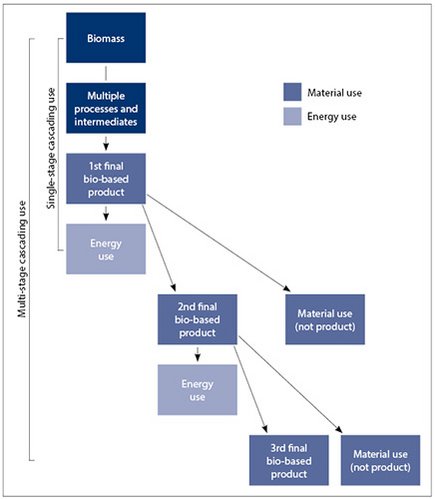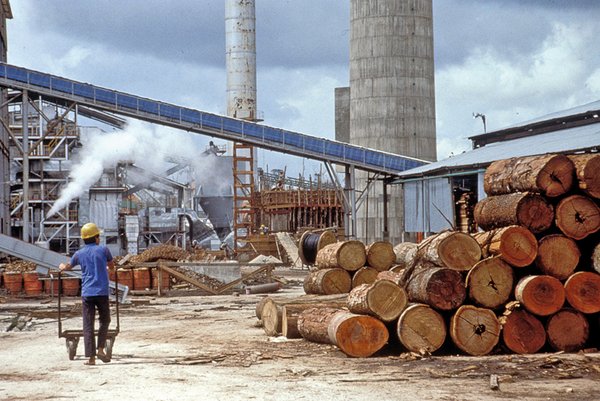 Download this article in magazine layout
Download this article in magazine layout
- Share this article
- Subscribe to our newsletter
Increasing resource efficiency by cascading use of biomass
The totality of plant, animal and microbial biomass is based on photosynthetic primary production. Biomass can serve in its material applications as a raw material for producing goods of every kind and as a direct component of the products themselves. This contribution is what distinguishes the material uses from energy recovery – where biomass serves solely as an energy source – and also from food and feed uses. There are many theories and concepts about cascading use of biomass based on different conceptions of what “cascading” means. These concepts cover various aspects, from repairable and second-hand products, to complex combinations of main, by- and co-products in what are called primary and secondary cascades. We find here thematic overlaps with other approaches, such as circular economy and recycling. The term “cascading” can also have different meanings in different contexts. However, all the various concepts have one thing in common: at some stage at least one product has a material use.
Defining cascading use of biomass
The following definition of the cascading use at the product level is intended to clarify the essence of the existing theories and concepts:
- Cascading use of biomass takes place when biomass is processed into a bio-based final product and this final product is used at least once more, either for materials or energy.
- Cascading use of biomass is described as “single-stage” when the bio-based final product is directly used for energy.
- Cascading use of biomass is described as “multi-stage” when biomass is processed into a bio-based final product and this final product is used at least once more as a material. It is only after at least two uses as a material that energy recovery is permitted.
The figure shows the material flows in single-stage and multi-stage cascading uses of biomass.
Distinction between single-stage and multi-stage cascading use of biomass

Single-stage cascading use already involves a significant increase in resource efficiency compared to direct use for energy recovery and can be applied to many existing bio-based value chains. Multi-stage cascading use results in bigger gains in resource efficiency. However, it has so far only been achieved from a very small number of biomass sources or has only been possible with a limited number of value chains.
In the Global South we already find widespread cascading use in the case of paper production. Starting as a raw material, wood is converted into cellulose, from which paper is manufactured. This paper can then be collected, processed as recycled paper and used sequentially as paper and cardboard. However, there are many other types of biomass with great – but as yet untapped – potential for material uses. This existing theories and concepts: can be seen in the case of fibres of plant origin (jute, sisal, cotton, hemp and others) and bioplastics. Natural fibres can be used to make textiles, which can be recovered after use, reused once again as a textile, and later turned into insulating materials or composite materials. The same cascade can also be followed by cellulose fibres, with wood being utilised as a raw material for the production of textiles.
Bioplastics can be manufactured from plants containing starch and sugar such as maize and sugar cane. Here, a cascading use might begin with the production of bio-based polyethylene terephthalate (PET) for use in the production of beverage bottles. After repeated use, these bottles can be transformed into polyester-based textiles. Another example of cascading use in the field of bioplastics is the production of polylactic acid (PLA) from maize. PLA can be used in an initial use as a textile and, in later steps, repeatedly serve as packaging material.
Ecological assessment: the case of the wood cascade
A widely quoted example of how biomass use can be cascaded is the wood cascade. The use of solid wood in furniture, the subsequent use of this furniture as a raw material for particle board, the possible recycling of particle boards and the final incineration describes a cascading use that improves resource efficiency by reducing the input of wood as a raw material for the same output of products. In other words, the raw material wood is used sequentially in a series of different applications and finally turned into energy. In so doing, it passes through “use cascades” that flow from a high value-added level to lower levels. Moreover, the deployed biomass acts as a carbon sink in as much as there is a long delay in the release of harmful greenhouse gases into the atmosphere that occurs with the direct use for energy recovery. In most cases, we can say in principle that the more stages of – where possible high-value – material use are passed through by biomass before its final use for energy recovery, the less will be the environmental impact. So, from an ecological standpoint, material uses are preferable to a direct energy use.
Barriers to cascading use of biomass
To date only a few examples of biomass cascades have been realised in Europe. The reasons are varied. Although recycling is accorded priority over energy recovery in the waste hierarchy of the European Framework Directive on Waste, the reality is that it is rare for a biomass stream to find its way into repeated material uses. The policy environment and regulatory system in Europe favours direct use for energy recovery. Other barriers to a roll-out of cascading use can include insufficient volumes, poor quality or contamination of the biomass stream. And there are problems concerning commercial viability of the supply chain and reprocessing as well as diminished technical properties of products. Products made of “recycled and supposedly inferior” base materials often have a negative image, and this can also be a factor behind the lack of cascades.
Opportunities for cascade use in rural areas
In addition to meeting the demand for food and feed, biomass also performs many other functions for the daily needs of the population. Derived timber products, natural fibres, chemicals and medical drugs are just a few examples of the wealth of possibilities offered by the material utilisation of biomass. As the bioeconomy develops, research will look into a host of other potential biomass applications in innovative bio-based products. In this context, the strategy of cascading use of biomass can make a decisive contribution to raising resource efficiency. This also applies to the rural areas, which have favourable structures for exploiting the large biomass potential. It is not only a matter of the actual harvested biomass from cultivation but also of harvest by-products, meadow biomass and biogenic processing waste. Every form of material use can serve here as the starting point for cascading use, with all its potential benefits for the environment and for employment – even if the new cascades are not at first “multi-stage”. The main point is: you can only incinerate once!
The cascades are currently being studied as part of the research project on “Increasing resource efficiency by cascading use of biomass – from theory to practice”, which is funded by Germany’s Federal Ministry for the Environment, Nature Conservation, Building and Nuclear Safety (BMUB) and overseen by the Federal Environment Agency (Umweltbundesamt).
For more information (in German): www.biomassekaskaden.de
Roland Essel
Michael Carus
nova-Institut GmbH
Hürth, Germany
roland.essel@nova-institut.de





Add a comment
Be the First to Comment